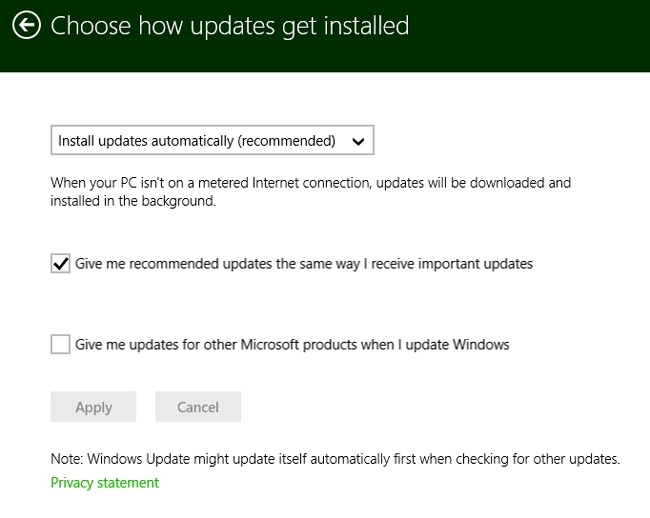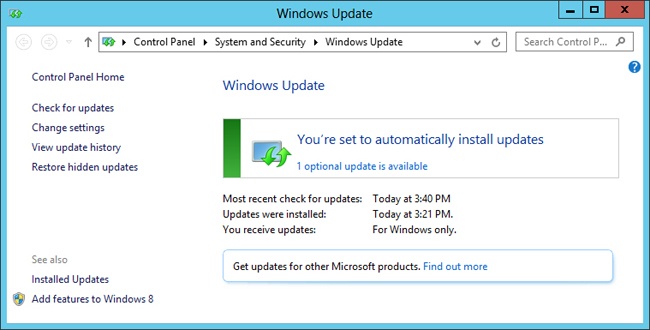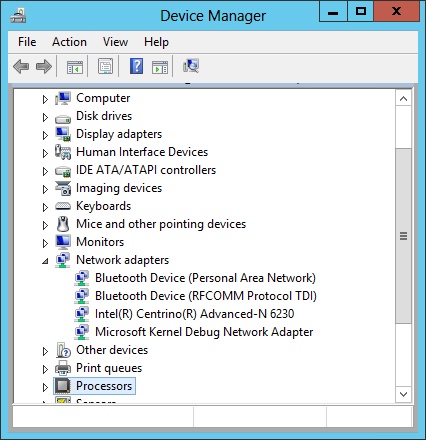Earlier versions of Windows required regular maintenance to keep them running smoothly: defragmenting your hard disk, checking your hard disk for errors, cleaning up temporary files, and removing apps that started automatically. Windows 8.1 has automated most maintenance tasks for you, and even an unmaintained PC should perform well after years of use.
However, you can do several things to keep your PC running quickly and reliably. This chapter covers the most important maintenance tasks.
One of the most powerful qualities of software is the ability of the developer to release updates after its initial release. Updates can fix problems, block security vulnerabilities, and add new features.
Updates can also be quite a nuisance. Windows and many individual apps regularly remind you to install some updates, and many of those updates require you to restart your computer.
Updates are a nuisance, but they’re important. The philosophy of “If it ain’t broke, don’t fix it” simply doesn’t apply in the world of software. A PC can be functioning just fine, but a newly discovered security vulnerability could threaten your data privacy and integrity if you don’t install a newly released security update. Similarly, updates might fix a relatively uncommon bug that will impact you at some point in the future, even if you haven’t yet noticed the bug.
The sections that follow discuss the different types of updates you should plan to install on your PC and how to retrieve those updates.
Note
Maintaining Windows 8.1 Watch the video at http://aka.ms/WinIO/maintenance.
Microsoft will release updates to Windows 8.1 on a regular basis. Microsoft releases several types of updates:
Security updates. An update that is intended to protect your computer from a newly discovered security vulnerability.
Critical updates. An important update that isn’t security related. Often, critical updates solve problems related to reliability or data integrity.
Windows Defender definitions. An update to Windows Defender definitions, which Windows Defender uses to detect the latest malware. For more information about Windows Defender, refer to Chapter 19.
Service packs. A large update that contains dozens or even hundreds of smaller updates. Service packs occasionally contain new features as well. Basically, a service pack contains all the minor updates Microsoft has released up to that point in time.
You should install each of these updates as soon as possible. I realize that installing updates that require you to restart your computer is a bit of a nuisance, especially if you’re like me and tend to keep many different apps open. Nonetheless, the few minutes of computing time you lose while restarting your computer can save you the hours or days of time that you would lose if a vulnerability on your PC is exploited or if a reliability problem causes issues with your PC.
Microsoft might release updates at any time, but Microsoft releases the most updates on “Patch Tuesday,” which is the second Tuesday of every month.
When you first set up your PC, Windows prompts you to configure automatic updates. If you later want to change how updates are installed, from the Start screen search for updates and select Choose Whether To Automatically Install Windows Updates from the search results.
On the Choose How Updates Get Installed page, shown in Figure 25-1, select your preferences. I prefer allowing updates to install automatically, but if you find the update reminders annoying, select Download Updates But Let Me Choose Whether To Install Them. Click Apply to save your setting.
By default, Windows installs your updates at 2 A.M. Presumably, you’re asleep at 2 A.M., so the updates won’t bother you. Here’s the problem with that schedule: your computer is probably also asleep. So, when you wake up and start your PC, that update will be waiting to interrupt your work.
You can configure automatic updates to install updates at a different time or to wake up your PC so that the updates can be installed while you’re sleeping. Open Control Panel on the desktop, and browse to System And Security, Windows Update, Change Settings. Then, click Updates Will Be Automatically Installed During The Maintenance Window. In the Automatic Maintenance window, pick the time to install the updates, as shown in Figure 25-2, and select the Allow Scheduled Maintenance To Wake Up My Computer At The Scheduled Time check box.
Optional updates include language packs and driver updates, and they’re never installed automatically. However, there will occasionally be optional updates that are important to you, so you should check for them regularly.
To install optional updates, open Control Panel on the desktop, and browse to System And Security, Windows Update. If necessary, click Check For Updates. If any optional updates are available, click the Optional Update Is Available link, as shown in Figure 25-3.
Now you can view the optional updates that are available. You don’t necessarily want to install them all, but you probably do want to install any updates for your PC’s hardware. Click Install to download and install the selected updates. Windows might prompt you to restart your PC to complete the installation.
To manually install updates, select Windows Update in PC Settings. Click Check Now even if Windows already shows that some updates are available, because Windows might not have detected newly available updates, and you might as well install everything all at once.
Although it’s never an issue for those among us who love to be the first to upgrade to the latest version, Windows has a life cycle. Microsoft releases a new version of Windows, and it remains current for a few years. Then, Microsoft releases a newer version of Windows, and continues to release updates for and support both the current and previous versions.
At some point, though, Microsoft has to stop supporting older versions of Windows. You’re welcome to continue running that version of Windows, but it’s probably not a great idea, because without that version being updated regularly, some attacker is going to discover a vulnerability, and they’ll be able to compromise your computer.
Compare it to the world of cars. The 1967 Chevrolet Camaro SS is one of my favorite cars of all time. If you were wise enough to buy one in 1967, you wouldn’t expect Chevy to keep it up to date by installing airbags or stability control. It’s simply impractical; at some point, Chevy needs to release a new model that incorporates those features. In fact, if you liked the 1967 Camaro, you probably wouldn’t even want those newer features.
Microsoft has to handle Windows in the same way. Windows 95 wasn’t designed for touch screens or the threats of the modern Internet, and it’s simply not practical to keep it up to date indefinitely.
So, at some point, Windows 8.1 is going to become outdated, and Microsoft is going to stop releasing updates for it and supporting it. The company hasn’t announced exactly when that will be, but Microsoft commits to supporting and releasing updates for “a minimum of 5 years from the date of a product’s general availability, or for 2 years after the successor product is released, whichever is longer.” Based on that, I would expect Microsoft to support Windows 8.1 until at least October, 2017.
Here are a couple of examples:
Windows XP was released on December 31, 2001, and supported until April 14, 2009.
Windows Vista was released on January 30, 2007, and supported until April 10, 2012.
For a complete description of the Windows life cycle, read the “Windows lifecycle fact sheet” at http://windows.microsoft.com/en-US/windows/products/lifecycle.
If you download an app using the Store, you also update it using the Store. As shown in Figure 25-4, the Store tile shows the number of updates available in the lower-right corner.
To install updates, open the Store and then click Updates in the upper-right corner. If you don’t see a link there, it means the Store hasn’t found any updates. You can manually check for updates by opening the Settings charm and then clicking App Updates.
Updating desktop apps is nowhere near as straightforward. There’s no single process, but the following are common approaches:
Desktop apps automatically check for updates when you run the app, notify you when one is available, and prompt you to download and install it.
Desktop apps have a separate app that checks for updates and notifies you when they’re available, even if you don’t run the app. I don’t want to single anyone out, Java, but these notifications can become really annoying.
Desktop apps include a menu item that allows you to manually check for updates. For example, the Help menu often has a menu item such as Check For Updates.
Microsoft desktop apps, such as Office, might distribute updates automatically using Windows Update. These updates will be installed the same way as updates to Windows 8.1.
Desktop apps might not be capable of checking for updates, but updates might be available on the software developer’s website. Visit the website to download the update. For best results, bookmark each app’s page, and add a reminder to your calendar to check for app updates monthly.
Because desktop apps install updates differently, people have a tendency to overlook them, leaving installed apps without the benefit of any new improvements. That’s one of the greatest improvements to the Windows 8.1 app infrastructure.
Almost every piece of hardware in your computer, including components hidden inside your computer, has a driver. A driver is a small piece of software that allow Windows to talk to your hardware.
Driver updates are extremely important because they can fix serious security, reliability, and data integrity problems. Microsoft distributes updates for signed drivers through Windows Update, so you receive some driver updates automatically.
However, the process of having Microsoft approve and sign a driver can take some time. As a result, hardware vendors often release driver updates directly through their websites. If you’re having a problem with a particular piece of hardware, first check Windows Update for a new driver. If you don’t find an update there, visit the hardware manufacturer’s website.
Often, hardware vendors have a different driver for every model that they make. So, it is important to know the exact model of your hardware. To determine the model of your hardware, from the Start screen search for Device Manager and run the app.
As shown in Figure 25-5, Device Manager lists every device in your PC. Browse the list to find the name of the device for which you want to update the driver, and then search the Internet for an update. For example, in Figure 25-5, the network adapter is the Intel Centrino Advanced-N 6230, the Kernel adapter will be updated only with Windows updates, and Bluetooth isn’t used for traditional network communications. Only download updated drivers from trusted sources.
Besides driver updates, some hardware manufacturers release firmware updates. Firmware updates actually update the low-level software that runs within the device itself. Firmware updates are infrequent, and most devices will never have a firmware update.
Your PC has a BIOS, which is low-level firmware that resides on a chip on your motherboard and runs before Windows starts. Occasionally, PC and motherboard manufacturers will release an updated BIOS to solve newly discovered problems and to support new hardware or software introduced after the motherboard was released.
Installing the latest BIOS can solve a wide variety of reliability and compatibility problems. It’s particularly important to check for BIOS updates in the first six months after a PC is released and in the first six months after upgrading to a new operating system. In other words, if you recently bought your PC or you just upgraded to Windows 8.1, you should check for BIOS updates.
If you bought a prebuilt computer, visit your PC manufacturer’s website and find the support page for your specific model of PC. If you built your own PC, visit your motherboard manufacturer’s website.
If you have a mobile PC, be sure the power is plugged in before installing a BIOS update. BIOS updates have the potential to damage your PC (though I’ve never had a problem), so you don’t want your PC to run out of battery power in the middle of a BIOS update.
If you store important files on your PC, daily backups are a critical part of your PC maintenance. Without backups, you will lose your files at some point, because all PCs fail at some point. For detailed information about backing up your PC, refer to Chapter 10.
Finding new apps is fun. Often, though, you use an app only once or twice. If you aren’t using an app, you should remove it to free up disk space and save yourself the trouble of installing updates. This is particularly true of desktop apps that run at startup.
You can remove Windows 8.1 apps by selecting them from the Start screen and then clicking Uninstall. To remove desktop apps, from the Start screen search for uninstall, select Uninstall A Program, and use Programs And Features to remove the app.
Disks aren’t perfect. Power outages, power fluctuations, running out of battery power unexpectedly, passing through magnetic fields, and even solar flares can cause data on your disk to become corrupted. These corruptions can damage your files. If Windows system files become corrupted, Windows might become unreliable, or you might not be able to start Windows at all.
Windows 8.1 checks for data corruption and will often fix it automatically. Therefore, you might never have to manually fix problems, but it never hurts to check your disk for errors.
For detailed information, refer to the section Fixing errors in Chapter 12.
You can never have enough storage. Especially if you take a lot of pictures or record videos, you’re bound to fill up your disk at some point. When you run out of disk space, you’ll be unable to save new files.
If your PC uses a conventional magnetic hard disk, your PC can actually slow down as your disk starts to fill up. For that reason, it’s especially important to delete any unnecessary files on a regular basis.
For detailed instructions, refer to the section Freeing up disk space in Chapter 9. For information about expanding your storage space by adding a new disk, refer to Chapter 12.
Rechargeable batteries lose capacity over time. If you can get nine hours of battery life when your PC is new, you might be down to five hours of battery life after two years. After five years, your battery might be completely unusable.
There are a few things you can do to improve the lifespan of your battery:
Use software from your hardware manufacturer to intelligently charge your battery. Some hardware manufacturers offer settings that charge your battery more slowly above 50 percent, which can increase your battery’s lifespan. This feature might be called “desktop mode.”
Store your batteries at 40 percent charge and keep them in a cool place. If you’re not going to be using your mobile PC for a few days or more, allow the battery to discharge to a little less than half before powering it down. Don’t store your PC in a hot car.
Every two or three weeks, run the battery down to empty. Batteries work better when they go through a full cycle on a regular basis. If you often run your PC without being plugged in, this shouldn’t be a problem. If your PC is constantly plugged in, however, it’s a good idea to unplug it once in a while and wait until the battery is almost empty before plugging it back in.





